DECEMBER DELIGHTS TO REMEMBER
I’ve reached the point in life where one of my real joys is looking back. My time travels in realms of memory follow many paths, and often they come unexpectedly and in more forms than I have ability to describe. Some are tiny moments frozen in my mind and probably having no meaning whatsoever to anyone but me. Others involve larger matters. For example, as is likely true of about everyone old enough to remember where they were and what they were doing when they received word John Kennedy had been shot (I was in college and on the oval in central campus kicking around a soccer ball) or the same for 9-11 (my wife, who was at our daughter’s visiting, called me crying and told me to turn on the TV those moments are frozen in my mind.). But in my world, the strength and staying power of Christmas memories exceed all others.
I’m not sure why, but it’s likely the product of a whole bunch of interacting factors. Certainly the season was celebrated, and in a major way, in our family. We didn’t have a great deal of money and there weren’t lavish gifts, but those I did receive were often deeply meaningful as well as being functional—my first shotgun and the first book I could call my own (I still have both of them), pocket knives and later a sheath knife, a handy hatchet, Duxbak hunting attire, ammunition, and the like. Then there was the deeply rooted sense of family and lots of time shared with not only my immediate family but grandparents, aunts, uncles, and cousins; sumptuous and scrumptious meals when the Casada clan gathered; rabbit hunting and the undeniable pleasure of going out with my only companions being canine ones for a day of mixed bag hunting; two solid weeks (three once I was in college) of relief from educational demands; festivities at church, school, and in the community; decorating; and so much more.
Virtually all of those now belong to a world I have lost, although my daughter and granddaughter take great delight in decorating, and I have no doubt whatsoever that I will be well and fully fed come Yuletide. Yet it is memories that feed my soul, and I’m sharing some of them, just tidbits out of time that come to mind. I rather suspect many of you, especially if you happen to be a bit long in the tooth or spare of hair, have similar ones. Then I want to wind things up with ruminations on the decorative side of Christmas from my boyhood. That portion is a reworking of the chapter on “Natural Christmas” in my book A Smoky Mountain Boyhood: Memories, Musings, and More. The book, which to my inordinate delight has been recognized five different times with accolades such as the top work in the Southeastern Outdoor Press Association’s annual excellence in craft competition and an award of merit from the North Carolina Society of Historians, also contains other tales of Christmas (“Christmas Heartbreak” and “Momma and the Spirit of Christmas,” along with thoughts on December in general). It is one of my two specials of the month (see details below).
MEMORABLE TOUCHES OF OLD-TIME CHRISTMAS
*Kids drawing names at school for the exchange of gifts.
*Chocolate cherries being one of the most common gifts growing out of such drawings.
*Making, usually with the help of your mother, some special gift for your school teacher.
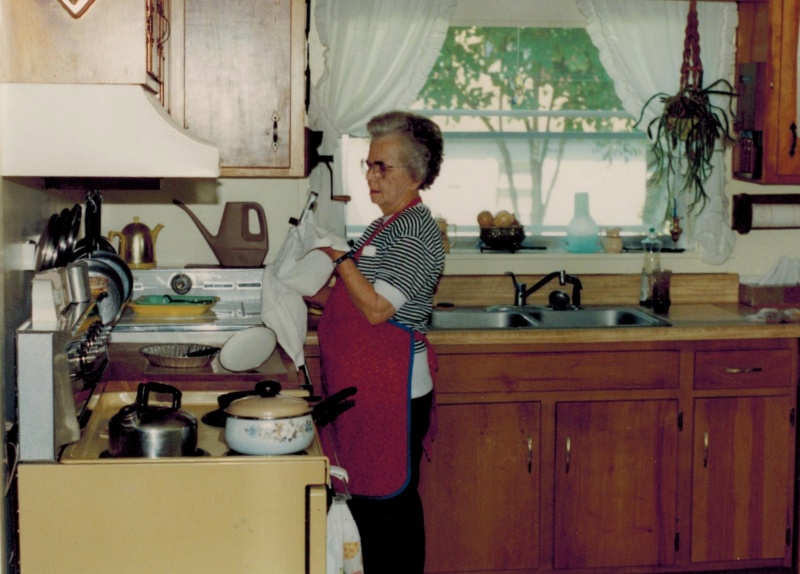
Momma in the kitchen cooking.
*Enjoying fare you had at no other time of the year (with the possible exception of Thanksgiving)—ambrosia, persimmon pudding, chestnut dressing, Momma’s applesauce cakes, orange slice cake, sweet potato casserole and sweet potato pie, pumpkin chiffon pie, and much more.
*Taking rides on Christmas Eve as light gave way to night in order to see and enjoy decorations in the community.
*Special events for kids at the Rotary Club and church.
*Folks showing up at the door and cheerily greeting you with shouts of “Christmas gift!”
*Going hunting the day before and the day after Christmas, and as a part of the latter outing, enjoying a bounty of leftovers from the Yuletide feast.
*Making decorations for the family tree using crepe paper, natural materials (see below), strings of popcorn, and the like.
*My parents’ efforts, and they were common throughout the little mountain community of my youth, to see that those less blessed (and mind you, we were anything but affluent) had something special at Christmas.
*Being fascinated by what were known as “bubble lights” decorating our tree.
*Having my own small Christmas tree—one I had personally selected, cut, and decorated—in my room. Interestingly my granddaughter, even though she is now out of her teens, still enjoys doing something similar. However, the days of a kid going into the woods and cutting their own tree are long gone.
*Enjoying all the things you could do when it snowed (and there was almost always a snow sometime during the Christmas break from school)—sled riding, ice “skating” on a frozen pond although our skates were nothing more than leather-bottomed shoes, making snow cream, tracking rabbits to their beds, snowball fights, constructing snow men, and various other times of youthful frivolity. Once I reached my teens that frivolity sometimes included nighttime outings to sled ride at the local golf course with a date (which happened to be quite hilly and offered plenty of opportunities for quite long rides without anything impeding the sled, and if you were lucky maybe the girl would hold your hand as you walked back up the hill for another ride).
*Christmas carolers from church coming to our door.
*Russian tea (which my Grandpa Joe call “Rooshian” tea and sassered and slurped when it was so hot most folks couldn’t touch it) being served in the afternoon.
*Sneaking down the stairs in company with my sister to view the presents at an ungodly Christmas morning hour (but about the same time as I would have gotten up for an all-day rabbit hunt).
*Kumquats as decorations—I haven’t seen one in stores or anywhere else in a ‘coon’s age, but they were commonplace in my boyhood.
*Eating seeded Muscat raisins (they came in a cluster, dried as a bunch just the way they had been picked).
*Special treats given to my father at the plant where he worked—I remember white fruit cake, Claxton fruit cake, canned white peaches, salted nuts, and other tasty delights.
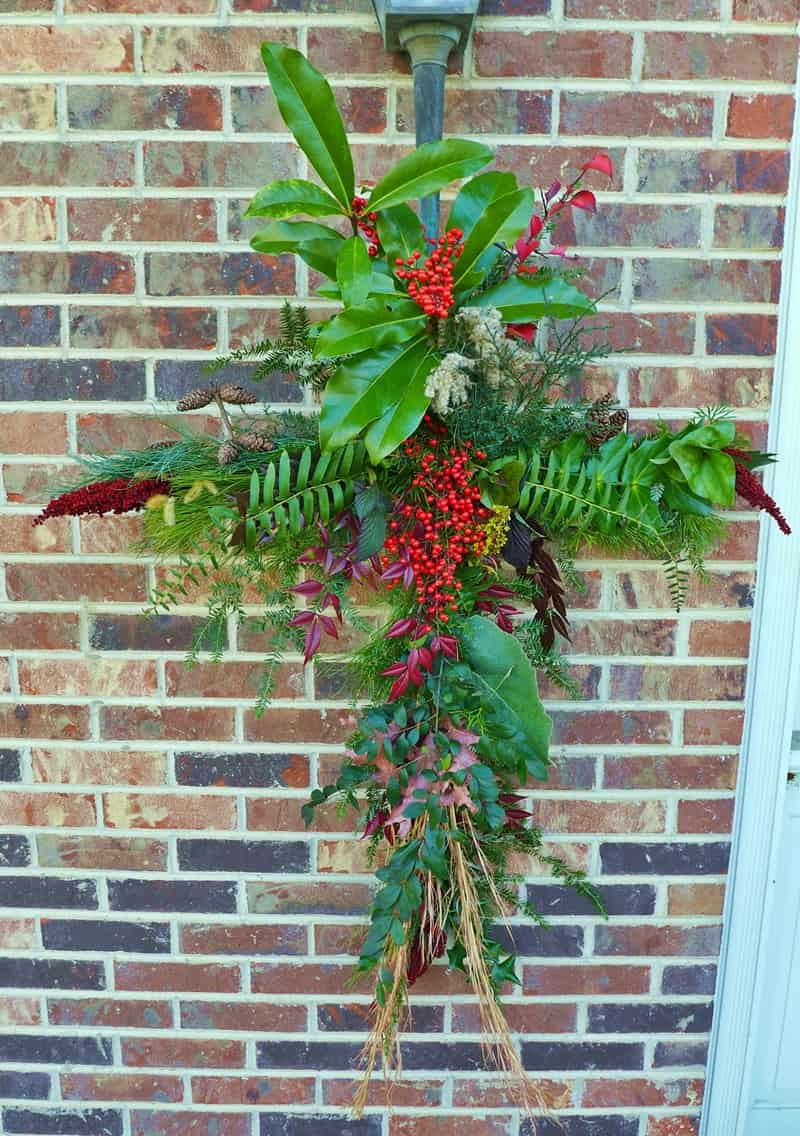
One of Don and Susan’s Christmas Crosses
Along with those varied memories, an overriding recollection involves how we decorated—the materials used, how they were procured, Mom’s delight in the whole process, and more. What follows is a glimpse of that world of what might be described as “A Natural Christmas,” because the vast majority of our decorations came from nature. My brother, Don, continues the tradition in a fetching and creative way—each year he and his wife wander the fields and woods of our highland homeland and gather pretty much whatever materials attract their visual attention. These are then creatively turned into a decorative cross, and invariably it is a lovely reminder of the season and its truest, deepest meaning. I’m sure Mom would have thought this continuation of her love of utilizing nature’s offerings to create things of beauty an exercise in pure wonderment. Here’s some of what I recall and I’d love to hear from readers regarding their own experiences and memories in this arena.
In today’s world, obtaining the family Christmas tree involves nothing more than a stop at a store, viewing trees stacked side-by-side in a vacant lot, or retrieving an artificial tree from the attic. Even an approximation of real “adventure” in obtaining the family tree involves nothing more than going to a Christmas tree farm and wandering amongst growing trees until one is spotted which strikes the fancy. Mind you, the Christmas tree industry has been a real economic boon for some mountain folks, but it marks a dramatic change from what was once common practice. During my boyhood virtually everyone cut their own tree, and often it involved an outing in which the entire family participated.
Our family search for the ideal tree, always a pine, began at Thanksgiving with the opening of the rabbit hunting season. My father and I would give every tree of the right size and promising shape a visual “once over,” and those with considerable potential would be filed away in our minds as “possibles” come tree-cutting time. When the big day arrived, always a Sunday afternoon about ten days to two weeks before Christmas, the whole family would pile into the car and head out to cut a tree. For us kids there was a sense of great excitement, and Momma, who enjoyed anything and everything connected with Christmas with all the eagerness, anticipation, and joy of an eight-year-old, fell right into the spirit of things.
Yet tree cutting was but one part of a wide-ranging Christmas decorating process, virtually all of which involved using materials from nature. Taking this approach offered three distinct advantages. Decorations from nature were lovely, cost nothing, and procuring and preparing them produced wonderful moments of family togetherness. I look back on those bygone Yuletides with a great deal of longing.
Mistletoe was a must, and it loomed large indeed in Mom’s overall decorating scheme. That in turn proved a boon for me, because I loved the entire process involved in obtaining quantities of it sufficient to satisfy her needs. In some places mistletoe grows low and can be gathered by the sack full with ease. Take a winter canoe trip down a low country river in either of the Carolinas and you’ll see big bunches of the leathery green parasite, loaded with waxy white berries, adorning one tree after another. It will be at a height where you can ease a canoe under it and pick enough for a major outbreak of kissing fever in no time at all.
In the high country of the Great Smokies, on the other hand, mistletoe seems to be comparatively scarce, and invariably when you find an oak, maple, or maybe a honey locust bedecked with a few clumps, they will be way up in the top of the tree. However, far from being a cause for dismay during my boyhood, that remoteness, scarcity, and inaccessibility presented precisely the sort of challenge a teenager welcomed.
Basically, there were three ways to procure mistletoe. Occasionally it was possible, provided one had the agility of a monkey and a virtual absence of fear (or common sense) to climb a tree to obtain mistletoe. Such challenges, especially the delicious hint of climbing danger, something which always appeals to a teenage boy, made that approach to obtaining mistletoe quite interesting. A second method, more commonly employed for the simple reason that finding a climbable mistletoe- bearing tree occurred infrequently, was to throw rocks or sticks at the clumps of greenery. Sticks with some heft and size to them were preferred for the simple reason they were far more likely to produce satisfactory results than merely chunking donnicks. The latter required too much accuracy, whereas a stick of some size cut a fairly big swath as it flew through the air.
My favorite tactic, however, involved shooting the mistletoe out. A tightly-choked shotgun would sometimes do the trick, although if the mistletoe was very high in a tree even the most closely patterned shot strings would spread out enough to result in tatters of mistletoe rather than sizeable clumps. Moreover, should you be lucky enough to shoot out a fairly nice-sized piece chances were it would have pellet holes all through the leaves.
On the other hand, a .22 rifle in the right hands was perfect. It required expert marksmanship to cut away a nice bunch of mistletoe right where it joined a tree limb, but that challenge was no small part of the fun. The “sport” became even more delightful if three or four boys were involved, each trying to outdo the other in demonstrating their shooting prowess.
My decidedly modest armory, which consisted of a single-barrel Savage Model 220A shotgun, a well-worn Daisy Red Ryder BB gun, and a slingshot, didn’t run to the luxury of a .22 rimfire. However, a good buddy did own one, and he was quite happy for all of us to take turns shooting it so long as each of us sprung for our own ammunition. Since .22 long rifle loads cost only a penny each in those days (less if you bought a box of 100 or if several boys pooled resources to purchase a “brick” of 500), even mountain boys who were anything but flush could afford enough cartridges to have real fun.
Our normal mistletoe-gathering days came on a Sunday afternoon a week or two before Christmas. You couldn’t hunt on Sunday and by that point in December one or more of our mothers would have mentioned needing some of this prime Yuletide decorating material. That was all the excuse we needed to head for the woods. Those of us–James Lee Sossamon, Frank Fry, Jackie Corbin, Bill Rolen, Bruce Parris, and others- -who regularly formed the youthful portion of the rabbit-hunting brigade led by my father and Claude Gossett had already been keeping a keen eye out for mistletoe in much the same fashion as Daddy always sought an ideal Virginia pine for our family tree. Accordingly, we always knew where plenty of mistletoe was available.
When several of us got together, relying not only on James Lee’s .22 but likely using his Jeep for transportation, it made for an afternoon of great fun. We would take shot about, tease one another about misses, brag about hits, and indulge in all sorts of verbal foolishness connected with thoughts of getting whatever girl happened to be the apple of our respective eyes at the time under some mistletoe.
I remember precious little in the way of positive developments in that regard, but I do fondly recall Momma’s pleasure and her special knack for making me feel good when I came home bearing a nice batch of mistletoe. She would make over the fresh greenery as if it was almost equivalent to gifts of the Magi, decorate it with red ribbon, and hang it at two or three likely places in the house. For a mountain boy of the 1950s it was an innocent, intriguing, and flat-out joyful experience.
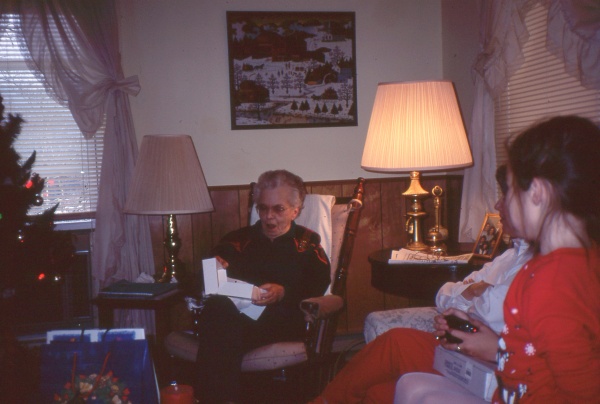
Momma opening Christmas presents
Along with a plentitude of mistletoe, Mom always wanted a few two- or three-foot long clippings from a honey locust tree. She disarmed the plentiful thorns by tipping each of them with a colorful gum drop, thereby making an unusual, attractive decoration. If a few of the gum drops mysteriously vanished thanks to the depredations of youngsters with a sweet tooth, Mom quietly replaced them and, in keeping with the spirit of the season, never uttered a word about missing candy.
Wreathes and table centerpieces made from natural materials such as hazelnuts still in the husk; cones from hemlocks, white pines, and other types of evergreens; sweet gum balls; sycamore balls; milkweed pods; old wasp nests; small bird nests, and the like were standard decorative features of Christmas. The sycamore and sweet gum balls could also be dipped in a flour-and-water mixture and then dried to give them a miniature snowball-like appearance. Alternatively, they could be painted silver or gold. These carefully crafted items gave Momma a great deal of pleasure, always drew favorable comments from visitors, and added appreciably to the overall festiveness of our house at holiday time.
Another approach to similar decorations focused exclusively on nuts—hazelnuts, black walnuts, hickory nuts, acorns, butternuts, and chinquapins. For visual variation, Mom always included some hickory nuts and acorns still in partially opened hulls.
Galax leaves were popular for wreathes, table decorations, wall hangings, and mantle adornment. During winter months galax leaves turn wonderful hues of red, purple, maroon, and magenta along with their basic green. Leaves also have a noticeable sheen and keep well for a couple of weeks. Galax is so attractive that at one time hardy mountain folks, always looking for a way to earn a bit of cash money, would gather it for wreathes or to form in great clusters to sell to city folks. Just as those who gather ginseng were locally known as “sangers,” those who pursued this seasonal work were styled “gallackers.”
She-holly (holly is one of a handful of trees, with persimmon being another one, which comes in male and female forms) with its bright red berries was always an important part of decorating for Christmas. It was fashioned into door hangings, used as edging around doors and windows, spread atop mantles, featured in decoration with candles, and more. Looking for a berry-laden tree was a standard sidelight to the search for a perfect Christmas tree in our family outing.
Cedar was another widely used evergreen, and cutting cedar branches, ideally adorned with plenty of the tree’s small blue-green berries, to use with holly, pyracanthia, nandenia, bittersweet, or other berry-laden plants was another means of turning to nature at Christmas. Daddy would have no part of a cedar tree for use as our family tree. Although cedars often have ideal shapes, he maintained that dealing with them, given the way they stuck and pricked the skin, just wasn’t worth the trouble. On the other hand, he readily acknowledged that using cedar for other decorative purposes brought a pleasing aroma to the house.
Running cedar (also known as ground cedar and by other names) likewise found its decorative place. This ground cover, found widely throughout the mountains, was easily gathered. It almost always occurred in large patches. Sometimes they covered a half acre or more.
Making garlands of popcorn for the family tree using popcorn we had grown, shucked, shelled, and popped was a favorite seasonal ritual. It provided double fun because some of the popper kernels would be salted and buttered. Thus you could snack while stringing popped kernels using a needle and strong sewing thread. Usually a large quantity of corn would be popped, and some would be blended with molasses to make popcorn balls. This was a marvelously messy process, and never did finger-licking seem more enjoyable.
Sometimes non-edible parts of game animals were fashioned into centerpieces for the festive holiday table. For example, deer sheds blended with greenery worked quite nicely in this regard, and a pair of wild turkey fans placed end-to-end made a nice oval atop which you could place she-holly or other berry-bearing greenery. Wall hangings featuring small deer sheds, turkey feathers, whitetail tails, grouse feathers, honey locust pods, and the like were also possible.
The foregoing offers but a sampling of items we used (not the deer- and turkey-related items, since both were extremely scarce in the Smokies of the mid-20th century, something which is today no longer the case) for holiday decoration. To the list could be added the limbs from white pines and hemlock which always figured prominently in the season, although thinking of the fate of the hemlock brings sadness to a season of gladness. One has to wonder if it is fated to go the way of the lordly American chestnut, which in its own right was an integral part of Christmas a century ago.
In yesteryear, as these approaches to decorating suggest, mountain folks turned straight to nature’s rich bounty for much of their Christmas preparation. The end result was simple beauty and a seasonal connection with the outdoors and the good earth. That link was an integral and important part of mountain life throughout the year, and it was only logical and appropriate that it be incorporated into the celebration of Christmas.
*********************************************************************************
THIS MONTH’S BOOK SPECIALS
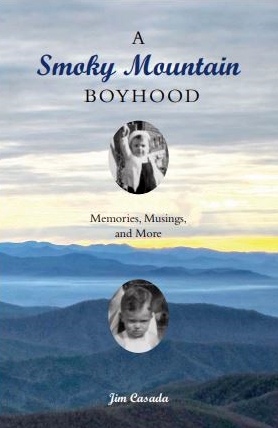
As I have already noted, there are three chapters, with goodly portions of one of them being utilized above, on Christmas to be found in A Smoky Mountain Boyhood. It has been a year since the book first appeared, and this is the first time I’ve offered it in any kind of special. From now through the end of the month, copies are available for $25 postpaid. Orders will need to be made by mail, because at this price I can’t afford to absorb the amount PayPal takes.
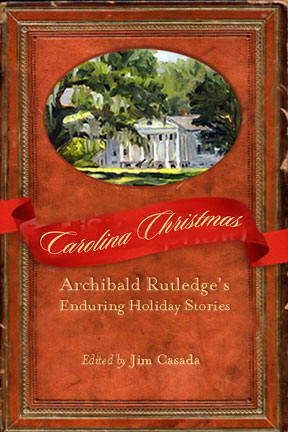
The same is true for the second special, Carolina Christmas: Archibald Rutledge’s Enduring Holiday Stories. This book, which features a wide selection of his Christmas and New Year’s tales, along with a lengthy original section on holiday foods at the end done by my late wife and me, is one I edited and compiled. It is also $25 postpaid. Both offerings are good for the month of December.
*********************************************************************************
JIM’S DOIN’S
It’s been a busy month on a variety of fronts. Sadly, a guy, Kane Gaskill, I coached in soccer some four decades ago, died after an arduous battle with cancer. The turnout of his old teammates and friends was absolutely amazing—I never cease to be impressed at how this group of guys has remained close over the decades. Following the service a large group of us gathered at his home to toast his memory and his lifelong friend, Greg Donlon, who came to Winthrop at the same time as Kane and also played soccer, offered a heartfelt and uplifting tribute to their friendship and the man’s memory. I offered some words of fond remembrance as well and all of us lifted a glass to a man who enjoyed his seasons in the sun and while doing so married a wonderful woman and produced two truly impressive children. It was a bittersweet time but in some ways actually uplifting.
Beyond that, I enjoyed Thanksgiving with plenty of gustatory goodness at my daughter’s home, and I even contributed a persimmon roll to the food offerings. The recipe appears below. On the writing front, I’m busy trying to cobble together and/or finish three different books or book proposals. One is the collection of profiles of mountain characters I’ve been working on for some time, the second is a cookbook/Appalachian foodways effort to be done in tandem with Tipper Pressley, and the third will be a guidebook to trout fishing in North Carolina.
As for publications, a number of things have appeared since the last newsletter. In Columbia Metro there’s “The Buck Stops Here: The Many Virtues of Venison,” Nov., 2021, pp. 84-90 and “Dialing in on Duck Dogs,” Dec., 2021, pp. 88-93. In the Dec./Jan. number of Smoky Mountain Living there’s “High Country Comfort Foods,” pp. 14-17 and “Fontana Dam: Triumph and Tragedy,” pp. 56-62. My nostalgic piece, “A Paean to Porches,” is in “Sporting Classics Daily,” Nov. 29, 2021.
************************************************************************************
DECEMBER FIXIN’S
PERSIMMON ROLL
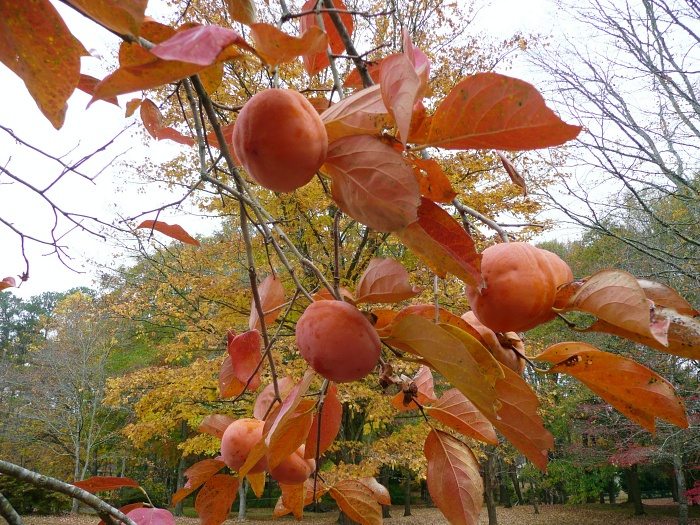
My good friend Tipper Pressley, who is also the technological wizard who readies these ramblings to share with you, recently offered a video on her dandy “Celebrating Appalachia” YouTube series on how to make a pumpkin roll. Incidentally, you can view this video, or scores of others she has posted, with a new one coming every couple of days, by checking out the title, “Celebrating Appalachia,” under YouTube videos. There you will find links to every video she has produced. That set me to wondering if it would be possible to substitute persimmon for pumpkin since I’ve got plenty of Asian persimmons from two trees I planted several years ago. After all, the texture of processed pumpkin and persimmon is quite similar, and other than the latter being somewhat sweeter, I figured it should work well. It did, and here’s a somewhat altered version of the recipe Tipper followed (hers came from a local cookbook).
¾ cup all-purpose flour
½ cup of sugar (or a bit less—ripe persimmons are very sweet and there’s a reason they are sometimes called “nature’s candy”
1 teaspoon salt
1 teaspoon baking soda
1 teaspoon cinnamon
¾ cup persimmon pulp
3 eggs
FILLING
1 package (8 ounces) cream cheese
1 tablespoon softened butter
Nuts (optional)
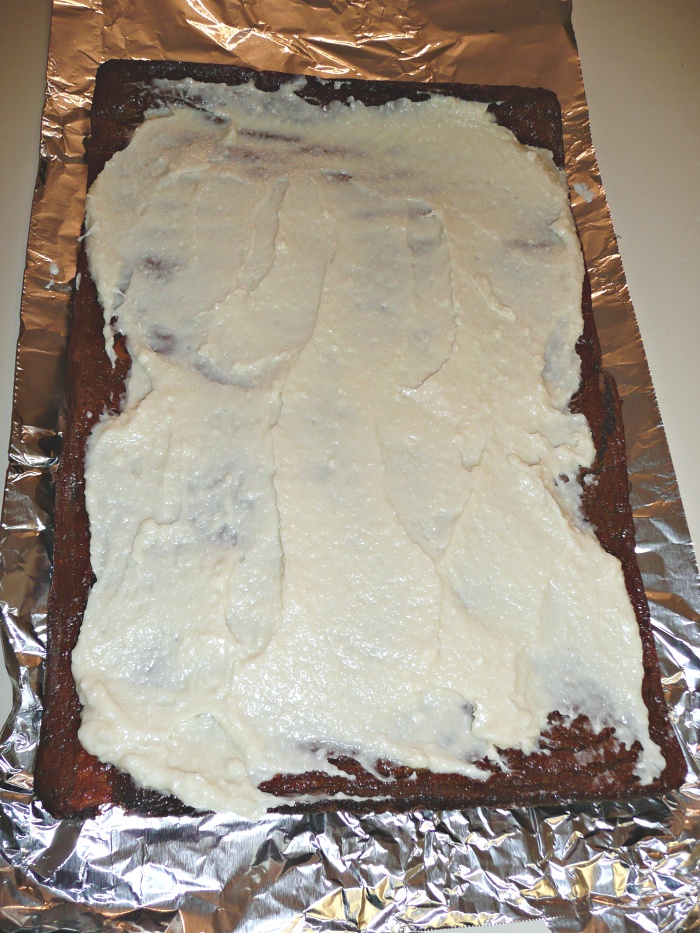
Mix the dry ingredients with a whisk then add persimmon pulp and one egg at a time, whisking as each egg is added. Pour the resultant batter onto a 10 x 15-inch cookie sheet that has been greased or covered with non-stick spray. Spread evenly and bake at 375 degrees for 15 minutes or until done. Remove from oven and allow to cool atop a rack. Once cooled, carefully roll the persimmon bread (because in essence that is what you have at this point) up and place it in aluminum foil or wax paper. Refrigerate for two or three hours.
To prepare the filling, soften the cream cheese (just remove from package and microwave for one minute) and mix with the softened butter. Open your roll out and carefully spread the filling evenly atop it. Roll back up (there will be some “memory” from it having been in the refrigerator cooling) and that’s it.
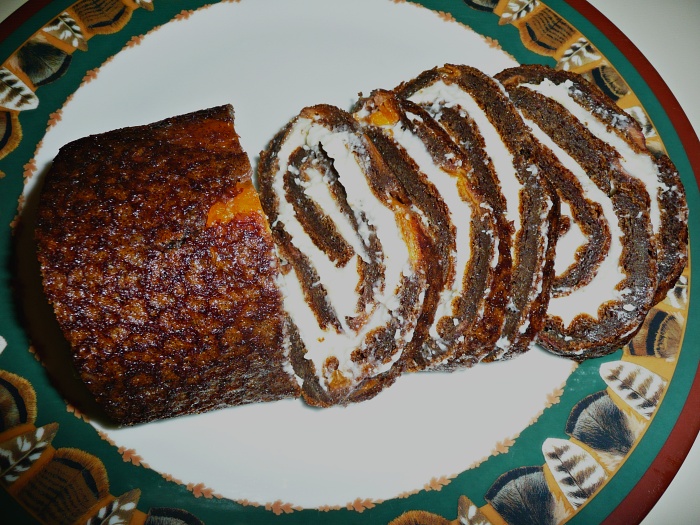 You have a persimmon roll which is eye-catching, tasty, and will make those who enjoy it think you are an absolute kitchen wizard when the preparation is actually quite easy.
You have a persimmon roll which is eye-catching, tasty, and will make those who enjoy it think you are an absolute kitchen wizard when the preparation is actually quite easy.
SIMPLE PERSIMMON PUDDING
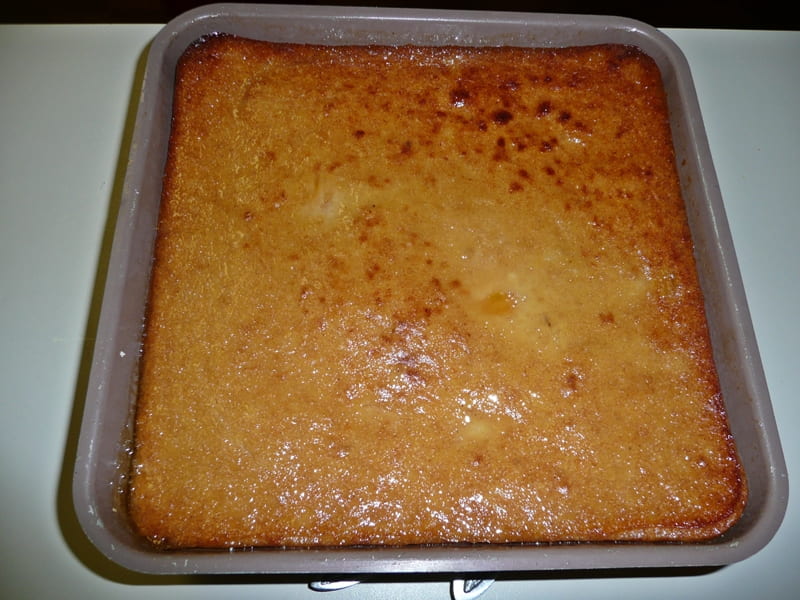
One of the great treats I recall from boyhood was persimmon pudding. It was rarely served because of the intense labor involved in gathering wild persimmons and extracting the pulp, but Asian persimmons taste just as good and are probably 30 times as large with no seed problem as an added bonus. That makes preparing a pudding much more feasible. There are many ways to fix this dish, and some recipes are actually more a bread than a pudding. Here’s a relatively simple approach.
1 cup persimmon pulp
2/3 cup sugar
3 eggs, beaten
1 cup all-purpose flour
1 teaspoon baking powder
½ teaspoon nutmeg
½ teaspoon cinnamon
1 cup whole milk
¼ cup butter, melted
Combine sugar and persimmon pulp then stir in (I use a whisk but presumably a blender would work) eggs, then milk, then butter. Mix dry ingredients together and then whisk thoroughly with the persimmon mix. Pour resultant batter into a well-greased 9-inch baking pan or Pyrex dish and bake in a 325-degree oven for an hour or until a knife comes out clean. Allow to cool before slicing into squares for serving. NOTE: This is a rich dish so a small square is a precious plenty.
VENISON BRUNSWICK STEW
This season has been a good one thus far in terms of deer hunting, and I’ve got a goodly supply of venison in the freezer with almost a month of hunting (and some unfilled tags) ahead of me. It’s probably just as well with beef prices soaring far beyond my financial comfort level. I reckon this hillbilly can survive on just fine on meat I’ve killed, cleaned, processed, and cooked (mind you, a couple of cherished friends and hunting buddies make the cleaning and processing a lot easier, thanks to having all the needed equipment and a real knack for the work). One of the best ways to enjoy venison in the heart of winter is in soups and stews.
3 pounds venison, cut into small cubes
1 large onion, chopped
1 large potato, chopped
2 stalks celery, chopped
1 large can tomatoes, chopped
1 tablespoon Worcestershire sauce
1 10-ounce package frozen lima beans
1 10-ounce package frozen corn
1 teaspoon salt
Black pepper or hot pepper flakes to taste
Brown the venison in a large Dutch oven holding two tablespoons of cooking oil. Add onion and sauté. Add other ingredients except frozen veggies and cook for an hour. Add frozen veggies and cook until tender. Check for taste and adjust seasonings. Serve over rice or with cornbread.
ITALIAN VENISON SOUP
½ pound ground venison
¼ cup chopped onion
1 14-ounce can Italian stewed tomatoes
1 16-ounce can peeled tomatoes chopped (I substitute tomatoes I have frozen)
1 can rich beef broth (or make you own from beef base)
1 8-ounce can mixed vegetables, drained
½ cup canned kidney beans, drained
5-ounce packaged chopped, frozen spinach, defrosted
1 teaspoon Italian seasoning
¼ teaspoon garlic salt
¼ teaspoon black pepper
½ cup uncooked macaroni noodles
In a large saucepan or Dutch oven brown venison and onion. Add other ingredients except noodles and bright to a boil. Then add noodles, Reduce heat to medium and cook 10 to 15 minutes or until macaroni noodles are done.